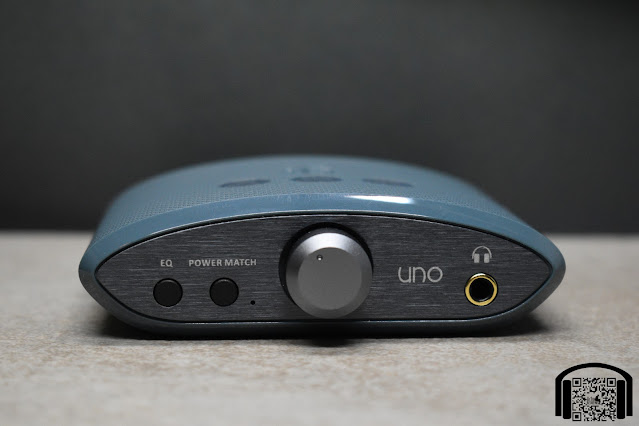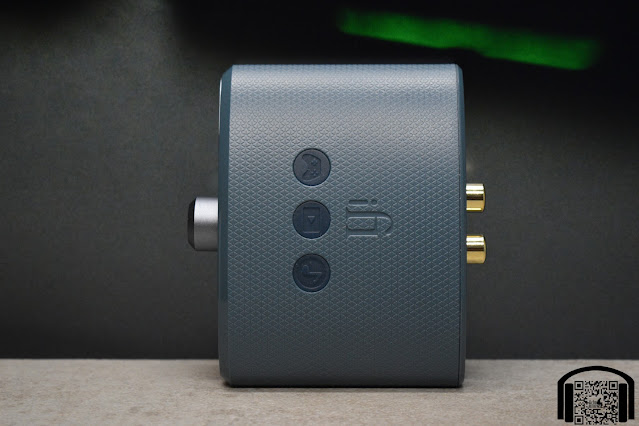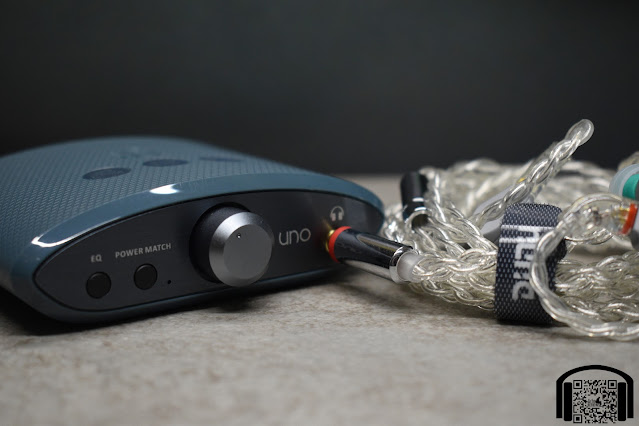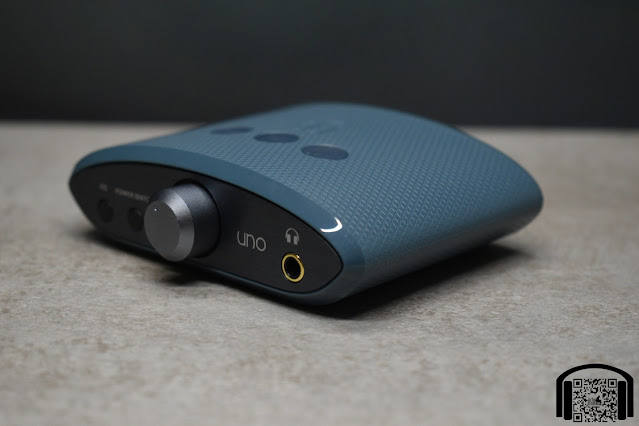- Get link
- X
- Other Apps
English | Español
TLDR version on YouTube: TDLR - iFi Audio Uno
The iFi Audio Uno was sent to me directly by iFi Audio in exchange for the publication of this review. iFi have not made any specific requests and I will follow my aim to be as honest and unbiased as humanly possible, as with all my reviews.
You can find the official page for the iFi Uno here: https://ifi-audio.com/products/uno/
As always, this is a non-affilate link.
Intro…
The Uno is a recent launch from iFi Audio and I have to say that I feel it is a very good piece of equipment. I am not referring to the performance of the device (I will talk about that in a moment) but more the fact of what it is and who it is aimed at.
For those of us that are immersed in the land of headphones, IEMs, DAC’s, amplifiers, etc. we would probably think “why would iFi launch a device like this?”. Yet for the vast majority of people out there who use headphones (or desktop speakers), they probably don’t even know what a DAC is, much less if they need one or not.
If we take a look on Amazon, there are a bunch of cheap items labelled as “soundcards” and quite a few budget USB audio interfaces also but in most cases, the quality of the audio we get from these devices leaves a lot to be desired. Yes, there are exceptions, but that usually involves research and to research something, you need to know what it is that you are researching. So many times, things are just purchased based on price versus number of stars on Amazon (which can also leave a lot to be desired).
Here is where the Uno enters the game. iFi are obviously a company that have been in the audio game for a long time and have experience making some very good stuff and while they already have a budget line of DACs and amplifiers (the Air line, which I tested not too long ago), they can still be a little overwhelming for those that know nothing about what they are or what they do. The Uno is a little different, it is a very simple device, with simple EQ options that is aimed to just “work” for those that probably don’t even know what they are missing until they try it.
I don’t think the Uno is something that is going to make the wish list of most audiophiles but have to say that I have been using it as an all-in-one desktop solution for the past week in my office and it is something that I could see most of my co-workers enjoying without even knowing what it is.
Presentation…
The Uno arrives in the typical iFi style, a white box that is simple but shows enough info on the exterior, with a card insert that slides out containing the device and the typical iFi paperwork. Along with the Uno, we get a USB A to USB C cable and that is it. But that is all we really need anyway.
Build and aesthetics…
My first thought when I got the Uno out of the box was “Wow! This is tiny!”. I had seen photos and obviously the box is also small but it wasn’t until I actually had it in my hand that Irealized how small and light this device actually is.
The exterior is built from plastic, similar in build and aesthetics to the iFi Air range, fitting easily in the palm of my hand and weighing just about nothing. While it is of course larger than a dongle, it is still small enough to fit in just about any bag or even the pocket of your jeans. I wouldn’t suggest trying to use it connected to your cell phone in your pocket but you probably could quite easily. I have seen DAPs that are much larger than a cell phone + Uno 😀
While being plastic and lightweight, I don’t have any complaints about the build (or aesthetics) of the unit. It seems to be well constructed and I have no doubt that it will withstand general use and abuse without issues.
One of the drawbacks of a device being lightweight is that the weight of cables will usually drag the device every which way, yet the Uno has two adhesive strips located on the bottom of the unit, allowing it to be fixed to whatever location is preferred.
Functionality…
The Uno is simple but it still has a few functions that will make basic users lives a lot easier.
On the back of the unit we find a USB-C port and a set of RCA’s providing an unbalanced output for speakers (or another headphone amp if you wish). O haven’t tried it with any Apply devices as I don’t own any but with Windows and Android I have experienced no issues with it connecting and being recognized. In fact, it is the only iFi device I have that works when connected to my docking station in the office, usually I have to connect them directly to a port on my PC.
On the front of the device, from left to right, we find the EQ button, the Power Match Button, the volume knob and a 3.5mm output.
Finally on the top of the unit there are 3 lights, one showing a gaming controller, one showing the YouTube logo and on showing a musical note.
As you may have guessed, these 3 lights on the top of the device show the EQ that we are currently set to. By pressing the EQ button we can cycle between off/gaming/video/music, each of them tweaked by iFi in an aim to provide the best response with the least amount of hassle.
The power match button is iFi’s way of naming gain, basically we can switch between high and low gain. For those that have no idea why we would want to do that (which I can understand a lot of those that may be interested in the Uno not really knowing), it allows us to increase the output level for things that are more difficult (or easier) to drive. In other words, if we have a set of headphones that needs more power, rather than turning the volume knob up to full, we just set the gain (or the Power Match in this case) to high and we can have more power available without needing to turn the know up as far. There is also a small white LED at the side of the button that shows when the device is in high gain.
The volume knob itself is very smooth and although it is small, I find it very comfortable to use. There is enough space around it to grip it correctly with two fingers and adjust without issues. The knob also serves as an on/off switch when turned all the way down. While turning the unit to off will disconnect it from our device, it is necessary to reach the actual resistive part of the knob before it disconnects (something that is not always the case on other devices, tending to disconnect before actually reach all the way down on the pot). If it is turned off, I found that when turning it back on, the connection was immediate, with almost no delay (at least on my Windos 10 machines).
That's it as far as functionality, you connect a USB cable from the source to the Uno, plug in either your speakers to the back or headphones to the front, and away you go.
My use case…
I actually went about this device in a different way to the usual way I would test a DAC/Amp combo. While I did try it out with some higher end headphones and feeding a couple of my desktop amplifiers, I really wanted to put this unit through its paces in the habitat that I feel it is designed for.
I placed the Uno on my desk at work and disconnected all other devices from my PC, focusing on using the Uno for my usual day to day life at my desk. This involves music listening, conference calls, some video content now and again and, in general, a little bit of everything.
I also aimed to use just some of the “normal” headphones and IEMs that I would usually have laying around in the office. To be totally honest, I don’t have that many “mainstream user” headphones, so I mostly used a few Koss models (the KPH40 are usually my office go to anyway), the Beyerdynamic Custom Studio, the Dunu Kima, the Cadenza and the HD6XX.
It is not that I am against trying out higher end headphones, it is just that, realistically, I can’t see someone who is using something like a Hifiman Arya looking at the Uno to drive them.
As far as the use of the device (I will get to sound in a moment), I have had no issues at all. It is simple to use and I really can’t fault it for the intended purpose. The only thing that I feel is a bit of a missed opportunity is the lack of a mic input.
I know that adding a microphone input would result in the need for an ADC (Analog to Digital Converter) and some way of controlling the level of the mic, which would add up to more complexity and probably more cost. However, as I see this as something to be used for simple gaming and multimedia etc., I think that a simple mic input would have been a big benefit to those casual gamers out there. I am not saying that it should have a professional studio mic input, just something simple like the mic inputs found already on PC’s and phones etc. I guess you could argue the fact that this is redundant, as PC’s already have these, but I still think it would have been something to attract those casual gamers who want to use something like a mod mic.
Again, not a complaint, just an observation from my side.
Sound…
This little device sounds surprisingly good. I honestly expected less in terms of sound quality from it!
Starting off with power, it had absolutely no problem driving any of the headphones and IEMs mentioned above to ranges way above what I would ever need. Even the HD6XX, which is a 300 Ohm set of headphones, was still driven well within the capacity of the Uno. I am not going to say that I haven’t heard the HD6XX sound better, I have, but I really don’t think that anyone who is not into the whole “synergy” and “last 10% quest” would have any complaints about the performance (unless they have actually heard the HD6XX on a system that brings out the best in it), I certainly don’t.
As far as the actual sound itself, well obviously it depends on the EQ selected. Let me just point out that the EQ function does not affect the output of the RCA’s, which remain constant no matter what EQ profile is selected. The same goes for Gain, it has no effect on the DAC outputs at the rear.
So here is a comparison of the 4 EQ modes via the headphone output. In this case, instead of just measuring the output into an interface, I took the measurements while driving the Dunu Kima IEMs (the ones I had closest at the time) so as to get a reference of real world changes (in other words, these shouldn’t be flat lines, the “No EQ” line is the one to be referenced against the others).
One thing to mention is than the EQ is done completely in the analog domain, something that is always the case with iFi Audio devices. This means that there is no change to the digital file, the EQ happens after this is converted to analog.
So, as you can see in the graph, there is quite a difference between frequency responces of the 4 modes.
The gaming mode adds quite a boost in the low ranges, along with a boosted 4 to 5kHz region. I guess (coming from a non-gamer) that this is to improve the explosions in the low range along with presence for things like footsteps. As said, I don’t game, so I can’t say how well this works but using this EQ for music does not work well for me personally. It brings out harshness in the tracks but that is not what the EQ setting is for.
The movie mode adds less of a boost in the lower ranges and brings up the 2 to 3kHz range instead of the 4 to 5kHz range. This works well for bringing out clarity in voices in a lot of movies. With movies (and series) that are dubbed into Spanish, the voices are a lot of the time los in a stereo presentation (i.e: without a center channel speaker) and this EQ actually works well to bring some clarity back and make the more intelligible. It also doesn’t work terrible for some music that has a lack of presence in vocals, such as “Make Noise”, where it helps bring the vocals of Busta Rhymes forwards. I wouldn’t personally choose this for music enjoyment (as the upper presence is a too much for the majority of music and can make it sound a bit fragile) but I do find it works quite well for movie content, especially that dubbed into Spanish.
The music mode just adds a boost to the low end, equal to the movie EQ but without touching the upper frequencies. While this is different to the XBass found on other iFi products (their XBass varies from product to product), the idea is the same and I have to say that I really enjoyed it with some of my more “bass shy” IEMs. It is a bit much for all of my lkistening but depending on genre and especially IEMs, I did find myself using (and enjoying) the music mode.
I guess I should also mention how the Uno sounds without EQ activated and I have to say it sounds pretty darn good. While it is not really the exact iFi house sound, it is still very reminiscent of it, giving a little warmth to the presentation without seeming to have a negative impact on the overall presentation. I am not sure how iFi manage to keep their “flavour” in their devices even when they move away from the BB chips they usually opt for, but they do.
Conclusion…
I have to say that I really think the iFi Uno is a great device for its intended audience. For those that spend a lot of time in front of a computer consuming different media content, then it offers a simple but well thought out way of doing so.
It’s small enough to fit anywhere, it could even be attached to the back of a laptop screen with the included sticky pads, and offers a performance that should be more than adequate for 99% of those who aren’t invested in that search of the holy grail in audiophile terms.
The Uno has a “sit back and forget it” sound to it, working well with almost anything I plugged into it and I can’t see why anyone who isn’t a declared audiophile would have any issues with the sound. In fact, even for those that are declared audiophiles but on a budget, I think it offers a lot.
I did mention that I would have liked to see a simple mic input for something like a boom mic but that is not a complaint, just something that I see would make it that little bit more appealing for the gamers and also those that would use it in an office environment.
Other than that, all I can say is that the iFi Uno is a surprisingly good little device.
All FR measurements of IEMs can be viewed and compared on achoreviews.squig.link
All isolation measurements of IEMs can be found on achoreviews.squig.link/isolation
To comment or contact, visit any of the following social media platforms:









